Review: Living with Symbian^3, Part Two
In the first part of my Symbian^3 review, I concentrated on the design of the home screen system and the general facilities provided in Symbian^3. This time, I'm looking at the core applications. What has changed, what has stayed the same, and what still needs to be done? It's all here. Also under the microscope is text intput, and by popular demand, PIM synchronisation, just how well can Symbian^3 talk to services beyond the Ovi world?
Version Reviewed: 12.003
Core applications
With a few exceptions, the core applications, which I define as: Messaging/Email, Contacts, Calendar, Dialler, Web Browser and Music; have seen few advances in Symbian^3. We're told that general UI tweaks and a whole new web browser will be coming to Symbian^3 devices early this year. We will report back on this as and when it happens. While we're still waiting for a new browser with better features to come along, it's fair to say that browsing with Web is enhanced in Symbian^3 thanks to the ample RAM and processing power, and pinch-to-zoom does make browsing an even smoother experience. General rendering speed and loading time is certainly on a par with Android's Dolphin browser (based on me comparing the C7 to the Google Nexus One). The main difference is how the page is displayed as it loads. As Steve reported:
"A core issue isn't actually that some pages don't appear to load fully or freeze - it's that Web's performance while loading isn't well optimised. On the iPhone and Android browsers (all based on versions of the core Webkit engine), it's possible to scroll around even before all the images and animations have fully loaded - from the user's point of view this is a natural thing to want to do (though as a programmer I'm thinking "No, let the page load before trying to confuse the application!") Hopefully the new version of Web will be much better at this sort of 'parallel' activity."
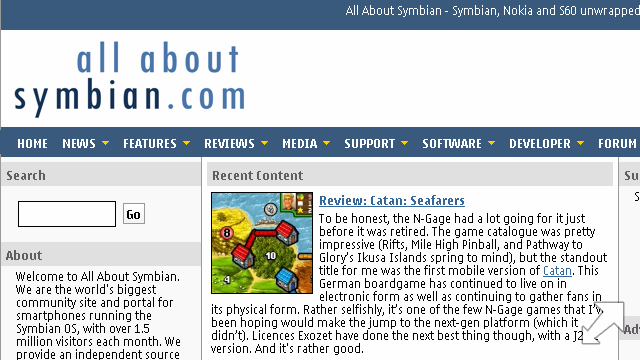
Web rendering AllAboutSymbian.com without a problem.
With the Messaging application, things are comfortingly the same as they were before. However, one thing has been added which was a glaring omission from S60 5th Edition, and that is a Conversations view. This is a simple function which many third party developers have tried to add to Symbian, although it just doesn't work as well when as a separate application - it needs to be integrated into the Messaging application. The Conversations view makes text messaging more enjoyable and also gets Symbian up to speed with iOS and Android.
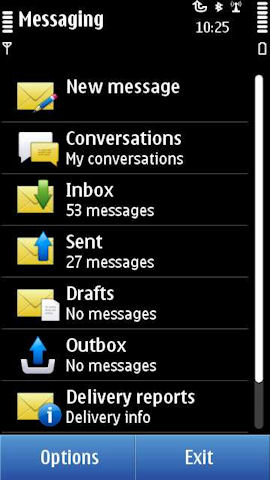
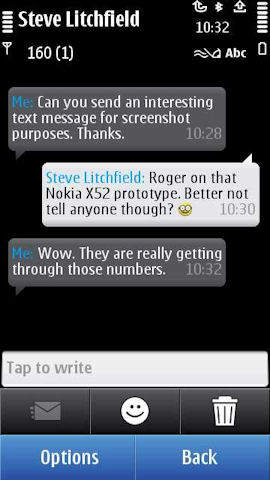
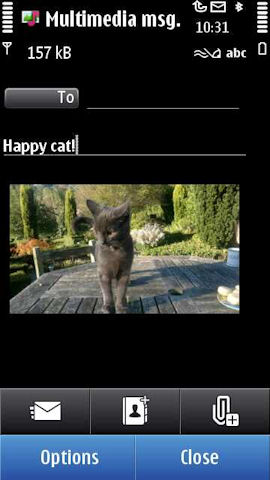
The Symbian^3 Messaging application with conversation view.
The Music application has seen something of a graphical renaissance with the iOS-like cover flow system. This has been made possible thanks to the graphics acceleration that is standard in all Symbian^3 phones. However, the Music application still sadly has the same glitches that it had before, along with a couple more in the cover flow implementation. The first minor niggle is that listing music by genre just presents an alphabetical list of tracks, without sub-ordering by album. Also, library refresh is still something of a hit and miss (mostly miss) affair. Manual updates are almost always needed when the music files stored on the phone have changed, and these scans can be just as slow as S60 5th Edition.
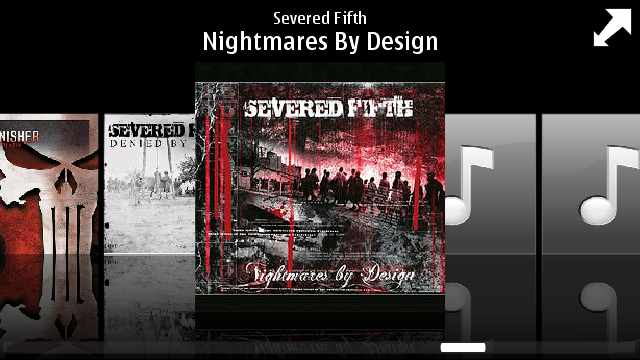
The Symbian^3 cover flow display in action, including album art place holders!
When it comes to the cover flow display, the frame rate is high and the kinetic animation is smooth - top marks. The main list that is presented to the user when they start the Music application is headed "Artists and Albums" which is immediately confusing and I find myself asking "Which is it? Can I not just have one or the other?". Also confusing is that this list is initially a simple 2D list, when in portrait. The 3D view isn't shown until the user either taps any album (remaining in portrait), or turns the phone into landscape; at which point the 3D rendering fun begins. Embarrassingly, we still see that the random nature of whether Music will display album art is still present, leading to more than a few place holding icons swooping past. I have done extensive testing with this, and I can find no pattern or trick to determine what will make Music show artwork for all albums.
If you want to read more about the multimedia performance in Symbian^3, read Steve's in-depth coverage from our N8 review, here.
The phone dialler app has had a welcome spruce up, and just has a more confidence inspiring look than previous Symbian touch screen diallers. It also incorporates the Quick Dialler system, seen in later Eseries devices, yet another example of Nokia bringing together the best of features from all their product lines. The feature works as explained by Steve in his real world usage review:
"The way it works is that you bring up the dialler from the 'Call' home screen shortcut and tap out a few 'characters' of a contact or company name using the one-handed predictive T9 keypad. For example, to find Dolly Hamilton in my Contacts list, I might end up typing '4264' ("hami") and possible matches are instantly shown in a scrollable list. Obviously, the more 'characters' you enter, the fewer the number of potential Christian name, surname or company matches and the greater the likelihood that you won't have to scroll at all."
On a final note about core applications, a plea to anyone on the Symbian development team who is reading this - please, give some attention to the Calendar application. The base design of Calendar isn't actually that bad, but the lack of an Agenda (free form list of upcoming entries) view is a major productivity speed-bump.
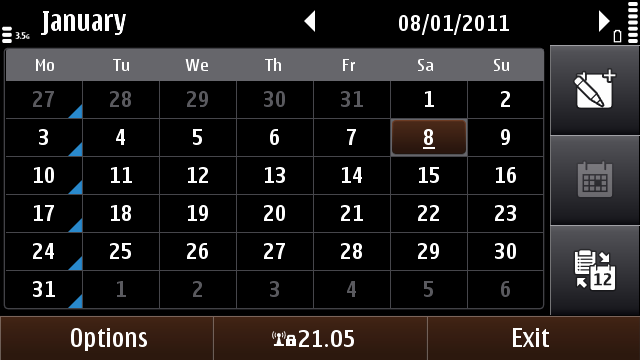
The new landscape layout of Symbian^3, as shown in the Calendar application.
Not exactly a core application, but Nokia Social should be acknowledged here. The idea of Nokia Social is to bring together Twitter and Facebook, and provide a degree of integration with your Contacts and Calendar integration. Sounds great on paper, but the version 1(.2) state does make itself evident. For instance, to associate social network friends with your Contacts database, you have to associate everything manually. Of course, it will suggest possible matches to you, but you have to approve every single one. On one hand, this is a safe approach, but compared to experiences of doing likewise on Android, one realises that the process of matching people to social network identities shouldn't be that difficult. Still, this is first generation software, so I look forward to seeing what Nokia do to update it. In the meantime, there is of course the awesome Gravity which you can buy for Symbian, and is the best Twitter client available on any mobile platform. You can read Rafe's take on Nokia Social here.
Everyday usage
The thing that shines through when using Symbian^3 is its unfailingly snappy performance. Thanks to ample RAM and the graphics acceleration, this is this the most responsive generation of phones we've seen from Nokia. The power optimisations in Symbian^3 seem to have born fruit too. The C7 I have been testing easily lasts for a day with its combination of 3.5" AMOLED screen and 1200mAh battery, on moderate usage.
When using Symbian^3, there is a definite feel that you have a solid phone platform in your hand, capable of doing anything you throw at it. Indeed, in all my real world usage of the C7 it has not crashed or complained about low RAM.
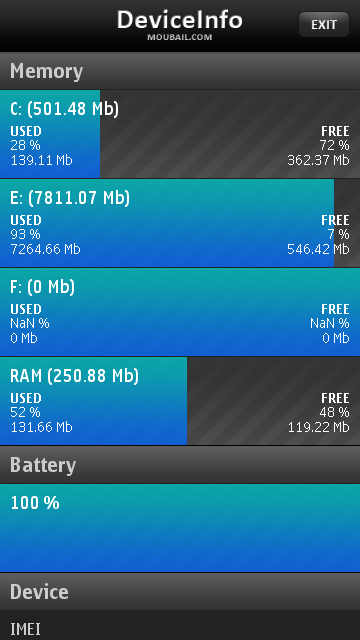
The typical state of a Nokia C7 under normal usage.
When it comes to text entry, Symbian^3 still uses the same 12-key T9 keypad in portrait but has a new landscape QWERTY keyboard. There is much debate in the blogosphere about portrait QWERTY on Symbian, and by all accounts it is coming. However, given the 16:9 aspect ratio of Symbian screens, a QWERTY keyboard could in fact be too narrow, but time will tell. In the meantime however, the virtual T9 keypad has the advantage of having large thumb-friendly buttons, which I have found to be quick enough to competently hold an Instant Message conversation - high praise!
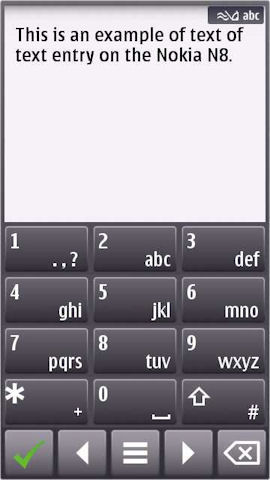
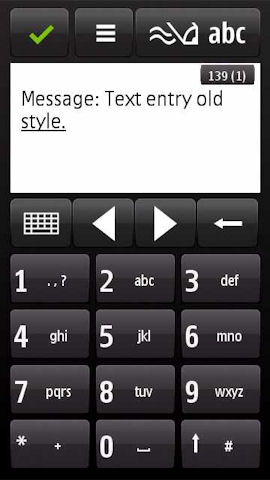
The new alphanumeric keyboard (left), compared to the one from Symbian^1 (N97, 5800, etc) (right)
Synchronising contact and calendar data still remains something of a black-art for many users. The Ovi Sync application is supplied, which is fine for the minority of users who live in the Ovi services. However, synchronising with the Google cloud, as I expect many tech enthusiasts will want to do, is still not straight forward. Of course, the recommended way to synchronise with Google is via Mail for Exchange (MfE). One can easily set up Nokia Messaging to talk to Google's MfE server, and that should be all there is to say. However, two problems soon present themselves. Firstly, trying to read an HTML email throws up an error about a security policy not being enabled. The only workaround to this is to delve into the MfE settings, disable email sync. Then set up a separate Nokia Messaging account for GMail. This then works great for displaying HTML messages, but there is no push notification. Nokia Messaging supports IMAP Idle [if you know the trick of setting it up - Ed], which provides near push timing, but it's variable. The other issue is that Nokia Messaging's MfE support will only synchronise with your own calendars in Google, not other calendars you have subscribed to. All this can be solved by turning to the paid-for third-party service, NuevaSync, which provides a reliable MfE sync service, even with any extra calendars you have subscribed to (see my review here).
Conclusion
What this review doesn't consider is the quality of Nokia's hardware and design. Couple that the solid advances made in Symbian^3, and the new range of phones are a compelling bunch, especially the N8 with its superb camera.
I still think there is much room for advancing and polishing the built-in applications with Symbian, but we are in something of a limbo state, knowing that the big firmware update is on its way, which could change much of what we've all reported on here at All About Symbian - that is the hope anyway!
David Gilson for All About Symbian, 7th January 2010.
Reviewed by David Gilson at
